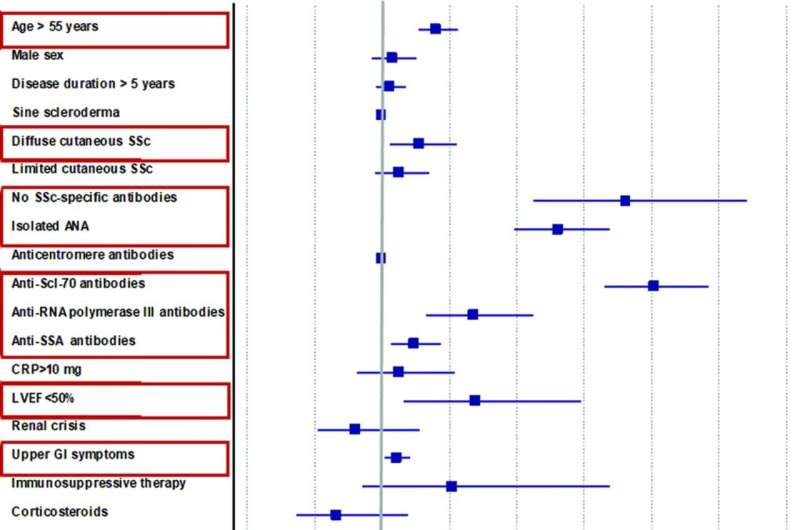This article has been reviewed according to Science X's editorial process and policies. Editors have highlighted the following attributes while ensuring the content's credibility:
fact-checked
proofread
Unpicking the complexity of systemic sclerosis

In 2023, The European Alliance of Associations for Rheumatology(EULAR) updated its recommendations for the treatment of systemic sclerosis (SSc), with many new inclusions around manifestations such as skin fibrosis and interstitial lung disease (ILD). However, there remains a need for better understanding of risk factors and more precise patient stratification based on organ-specific manifestations.
SSc is a connective tissue disease with variable clinical presentation. It may affect the skin, blood vessels, heart, lungs, kidneys, gastrointestinal tract, and musculoskeletal system—and this complexity and diversity makes it challenging to treat. This clinical heterogeneity in SSc may be partially explained by SSc-specific antibodies, but a better understanding of additional risk factors and patient stratification is still needed. Three abstracts shared at the 2024 EULAR congress present a selection of new clinical research to enrich knowledge in this disease.
First, Burja and colleagues presented the association between anti-Ro/SSA and lung involvement in patients with SSc. The work was based on clinical data from the EUSTAR database, the largest worldwide cohort comprising more than 4,000 patients with available data on anti-Ro/SSA antibodies.
They specifically examined the association of these antibodies with lung involvement in SSc, focusing on functional lung parameters, such as forced vital capacity—a measure of respiratory muscle function, and the presence of lung fibrosis.
The results showed that patients with positive anti-Ro/SSA antibodies more frequently presented with muscular involvement and lung fibrosis at baseline. Additionally, anti-SSA seropositivity was independently associated with the presence of lung fibrosis in at least one follow-up visit, and represented an independent risk factor for having lower diffusion capacity of carbon monoxide (DLCO). These data support the inclusion of anti-SSA antibodies in routine clinical practice to help improve the risk-stratification of patients with SSc.
Another EUSTAR analysis looked at changes in treatment patterns and their influence on the outcomes for people with SSc and interstitial lung disease (SSc-ILD). This is important, since options have expanded in recent years. But although this has reduced the number of observed progressive ILD events, progression-free survival is still only 45% at 3 years.
In the new work shared at EULAR 2024, Campochiaro and the research team evaluated the impact of immunosuppressive treatments across a 3-year follow-up period on both progressive ILD events, and progression-free survival in 1,409 SSc-ILD patients. They found that treatment use had increased significantly, from 13.6% before 2006 to 57.4% in patients treated after 2017.
When assessing the impact of this treatment over an average of 3-year follow-up, they identified significantly fewer progressive events and improved progression-free survival in later time periods. In the full abstract—available on the EULAR website, and presented at the meeting—the authors also describe a sub-analysis based on the presence of anti-topoisomerase I antibodies.
In a different take on risk stratification, Fretheim and colleagues build on preliminary data that indicate COMPERA 2.0 may be the most accurate tool for risk stratification in pulmonary arterial hypertension associated with SSc (SSc-PAH). They suggest adding DLCO data to the risk assessment may improve accuracy.
To test this hypothesis, they collected data from SSc patients who underwent a right heart catheterization at the Oslo University Hospital between 2005 and 2020. Patients were grouped into those with improvement, worsening, or stable DLCO.
Over a mean observation period of 98 months, 56% patients died, with a trend towards better survival in patients with improvement in DLCO. These findings suggest that DLCO is sensitive to change in people with SSc-PAH, and support the inclusion of DLCO in risk stratification at the time of PAH diagnosis.
More information: B. Burja et al, OP0013 ANTI-Ro/SSA Antibodies are predictive of a more severe lung involvement in patients with systemic sclerosis: A study from the EUSTAR Hdatabase, Scientific Abstracts (2024). DOI: 10.1136/annrheumdis-2024-eular.1670
C. Campochiaro et al, OP0225 Changes in treatment patterns and their influence on the outcome of systemic sclerosis-interstitial lung disease (SSc-ILD) patients: An EUSTAR analysis, Scientific Abstracts (2024). DOI: 10.1136/annrheumdis-2024-eular.4351
H. Fretheim et al, OP0252 One-year trajectories of diffusion capacity of carbon monoxide as potential markers of outcome in systemic sclerosis associated pulmonary hypertension, Scientific Abstracts (2024). DOI: 10.1136/annrheumdis-2024-eular.2350





















